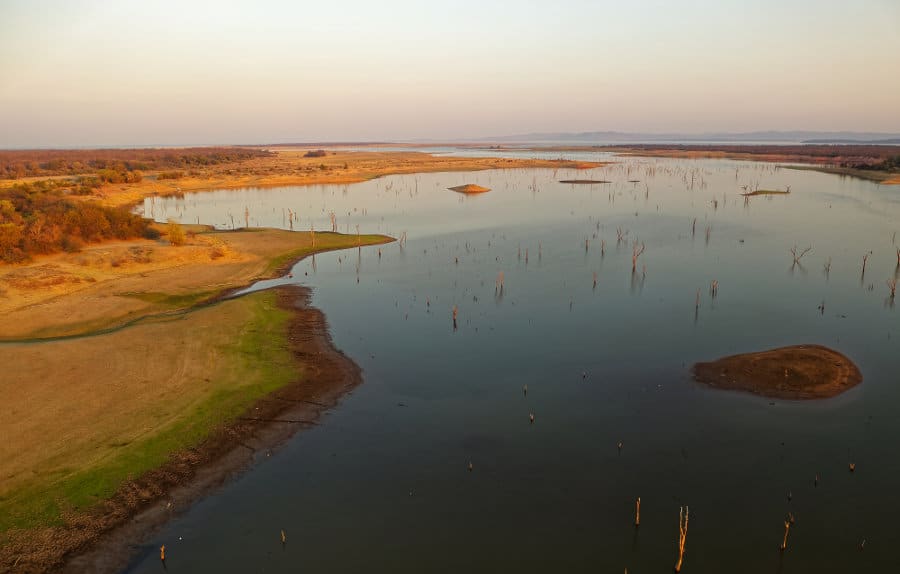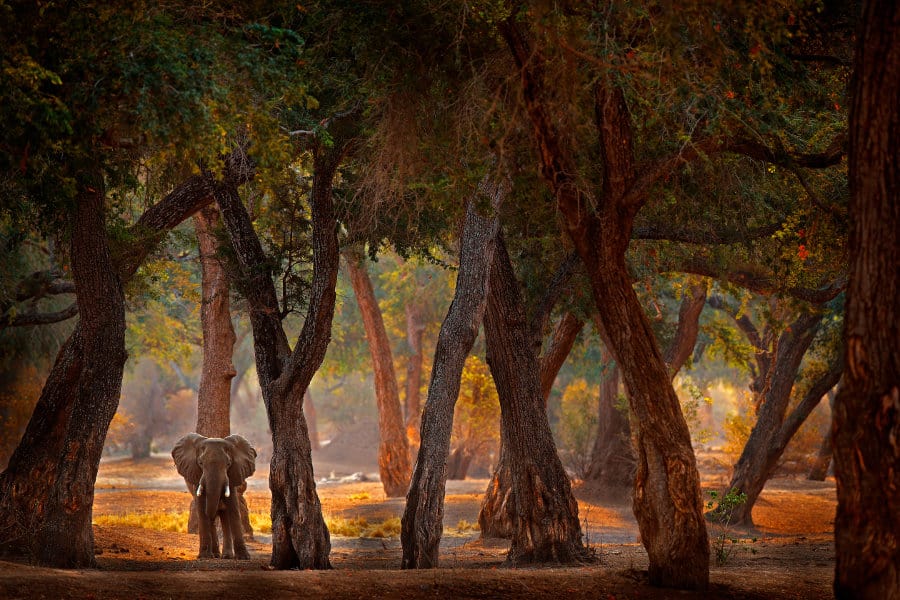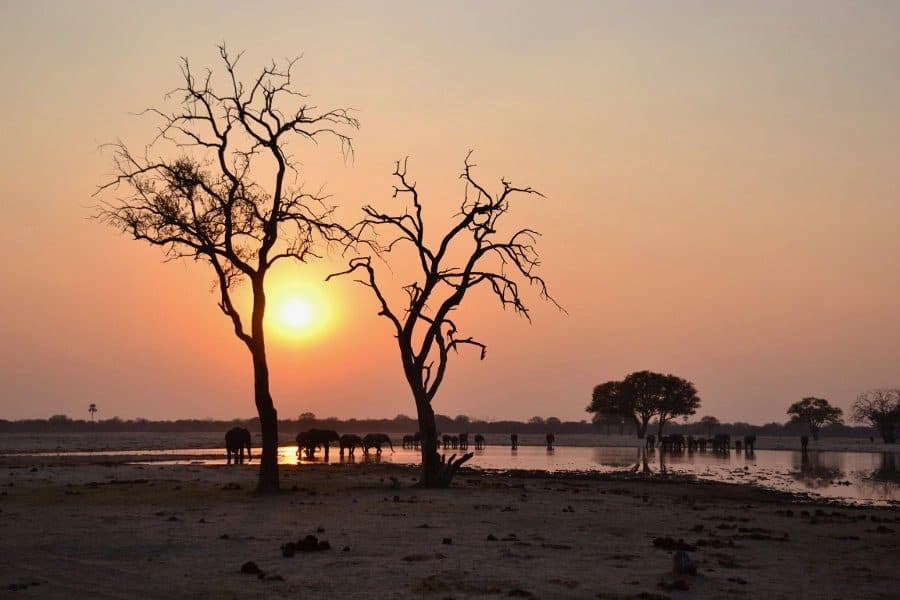Imagine the chance to explore grounds where the largest herds of elephants roam around freely. With undisturbed natural beauty, indulge yourself in a true African wildlife experience.
Journey off the beaten path and head into the wildest parts of Africa. Spy upon the quiet lives of wild dogs and listen to the crackling calls of hyenas. Come face to face with herds of zebras and listen to the echoes of roaring lions.
This guide covers everything you can expect from Hwange Park. Including the thrilling wildlife encounters you’re bound to experience. As well as all the wonder and excitement a trip like this could bring.
Where is Hwange National Park?

The grasslands and butterfly tree forests in Hwange make it the largest national park in Zimbabwe. Situated in the North West, it’s located on the main road between Victoria Falls and Bulawayo.
One of the perks of a trip to the park is that it’s easily accessible. Fly into Victoria Falls, which will only be an hour and a half’s drive away from the park.
Rent a car from the airport to make the journey to the park. Or simply organise a shuttle service to get to the Zimbabwe National Park.
Be sure to head up to the northern section of the park. The vegetation is sparse, which makes for the best game viewing.
4 Reasons to Visit Hwange National Park in Zimbabwe
There’s something that makes this destination special. These are some of the special perks of exploring Hwange.
1. It’s one of Africa’s top national parks

With over 15 000 square kilometers of untouched landscapes, there is an abundance of wildlife. Even though the park is as large as Belgium, its low flow of tourism means there is more open space.
The park having no fencing allows the animals to freely roam the vast grasslands. This offers a day filled with adventuring around the area.
2. The Big 5 call this place home
For most people traveling to Africa, witnessing the big 5 is a must. Cape buffalo, elephants, leopards, lions, and rhinos make up the famous 5.
Given that there is minimal human interference, the ancient and tranquil parts of the bush remain untouched by the outside world.
Step into the captivating lives of the big 5, without interfering with their daily lives and routine.
3. 50 000 elephants roam the savanna grasslands

Pretty spectacularly, Zimbabwe is home to the largest herds of elephants in the world. Hwange is one of the best destinations to spy upon the African elephant. Although, it’s not really spying when there are so many of them.
The giant creatures gather throughout the year. But huge herds will generally congregate around the drier periods.
4. The park has the biggest diversity of mammals
With more than 100 species of mammals and over 400 bird species, it’s one of the most diverse parks in the world. It’s also one of the only places in Zimbabwe that giraffes can call home.
African wild dogs are quite hard to come by. Even in some of the larger parks in Africa, they can be difficult to spot. The good news is that they’re regularly on the move here.
Some other wildlife animals you can expect to see:
- Hippo
- Zebra
- Hyena
- Cheetah
- Wildebeest
- Greater kudu
- Gemsbok
What to Expect for Your Safari in Hwange
Let’s talk about what you can expect from your wildlife experience in Hwange.
It’s a bird-watching haven
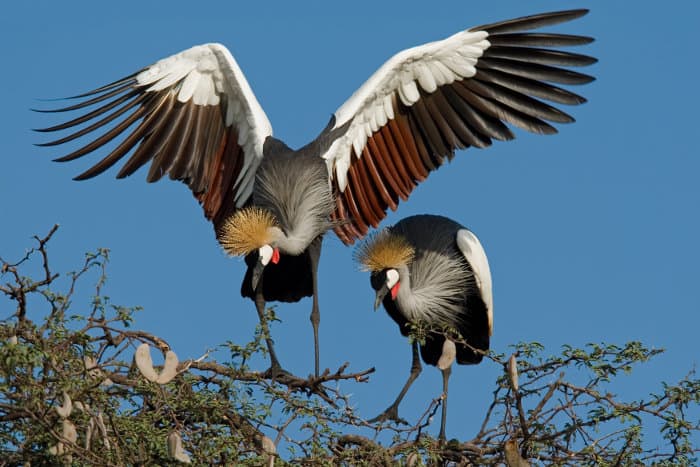
With around 420 species of birds residing in the area, it’s no wonder bird lovers find themselves in paradise.
No matter the time of year, visitors will be able to spot birds. Although the best time for bird watching is from November to April. Migratory birds make their way from Europe and Northern Africa to find good breeding grounds.
Despite this being a rare occurrence, lucky birdwatchers sometimes spot resident birds nesting. This provides a stunning look at their colorful breeding plumage.
The Bateleur eagle is very common and often seen soaring above the treetops. As well as 50 other species of raptors.
Grassland birds are also prominent figures in the Hwange landscape. They’re often spotted scurrying quickly through the tall grass.
Bird species you can look forward to seeing:
- Bradfield’s hornbill
- Bronze-winged courser
- African golden oriole
- Greater flamingo
- Egyptian vulture
Guided tours
Just like with any wildlife experience, a safari drive is an essential part of the trip. It’s a chance to engage with expert guides as you tour around the diverse landscapes.
Before booking a game drive, consider a safari that suits your needs. Game drives cater for families, large groups, or private bookings. There are plenty of options to make a safari experience unique.
There’s no time to sleep in or not be a morning person during a wildlife adventure. Waking up at the crack of dawn is going to show off the best parts of the bush.
As the sunset peeks up from behind the mopane woodlands, the animals begin waking up to start the day. That’s when you’re going to catch the most action. Safari game drives kick off as early as 6 am, usually accompanied by fresh coffee and snacks.
Budget-friendly options

If guided tours don’t fit your budget, fear not, because self-driving through the park can be just as scenically beautiful.
Spot diverse wildlife from the comfort of your own car, without the crowds of people. The only price required is the entrance fee.
With the wide range of accommodation options, finding a budget-friendly stay is more than possible. Nothing’s stopping you from indulging in a luxurious safari experience. It’s just good to know that you won’t need to break the bank for your chance at a wildlife experience.
Highlights include:
- A number of different activities besides safari drives. Take a pick from horseback riding, nature walks or birdwatching.
- Many other exhilarating activities surround the area.
- It’s a chance to spot the rare African wild dogs.
- Most of the park is accessible by 2×4 vehicles.
- Victoria Falls is only a quick drive away.
- Family camping sites and Hwange national park lodges.
The Best Time of Year to Visit the Zimbabwean National Park

The drier months, June through October, guarantee spectacular wildlife spotting. Due to the lack of rain, animals gather at the main waterholes to get their share of the cool waters.
There aren’t any natural waterholes, so the animals have to rely heavily on the water pumps provided by the park. Animal sightings are easy to come by with these conditions. Huge herds of elephants gather around these holes, making it the best park to spot ellies.
Be sure to book ahead of time for lodging in the drier seasons.
A trip to the park during the wet season, November to April, is more than doable too. The chances of spotting big wildlife are less, nevertheless, there are plenty of bird watching opportunities.
Where to Stay for a Hwange National Park Safari
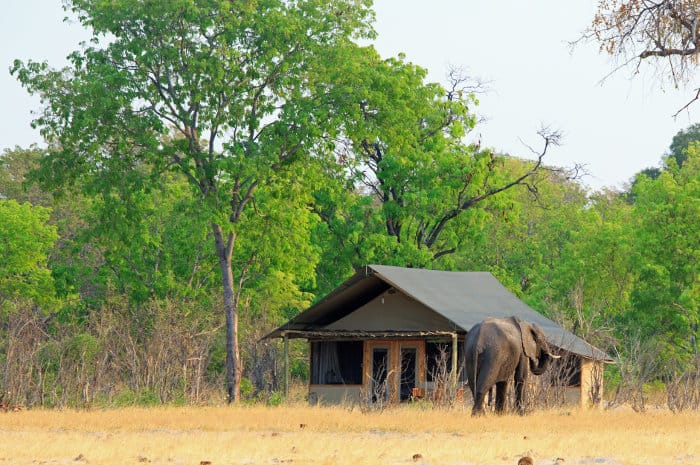
Private luxury lodges sit both inside and outside the park. Most of the time these luxury lodges are fully-inclusive, meaning travelers have access to the top safari activities.
There are three main camps inside Hwange, perfect for any traveler’s needs and budget. Affordable lodges and self-catering cottages are also available for a comfy stay. As well as wildlife camps and exclusive camps.
Surround yourself with the sounds of nature and wildlife action. An array of remarkable camping sites allows one to dive right into life in the bush. Set up camp and sit around the fire, as the fireflies and fruit bats start their day.
If the wallet allows, accommodation in luxury lodges is absolutely incredible. Often situated right on the water banks to provide optimal animal spotting. Watch across the decks as elephants splash in the waters, or lions lounging by the banks.
Malaria and Safety in the National Park
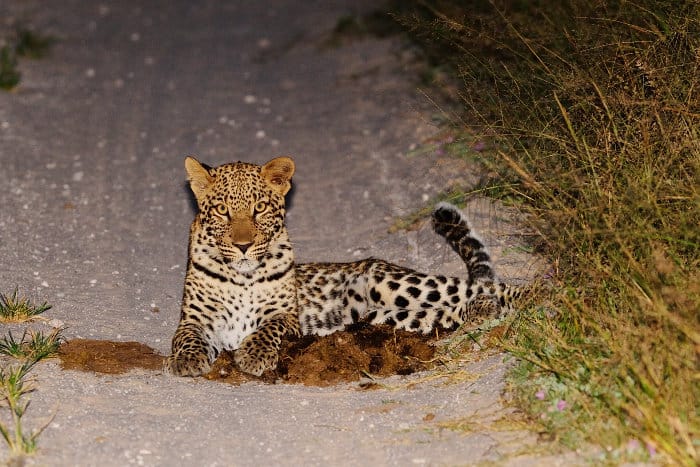
Hwange national park is in a malaria zone and one needs to take the right precautions. We recommend that travelers consider anti-malaria pills to protect themselves. Applying mosquito repellent is also going to help with sleeping in the bush. Especially if it contains DEET.
In general, Hwange is relatively safe. The only worry comes when opting for self-drive game drives. The roads are well paved, nonetheless, cars can potentially break down and drivers may not have communication with anyone.
Heading to Your Safari in Hwange National Park, Zimbabwe

Zimbabwe isn’t one of the most traveled destinations in Africa. It goes largely unforgotten when compared to some of the other popular parks, like the Kruger National Park.
However, a trip to Hwange is a must for those fascinated by African elephants, painted wild dogs and the huge array of bird species.
The park shows off the raw power of nature, offering something unique to gain from a wildlife experience. Plan the ultimate safari and get in touch with your wild side.

